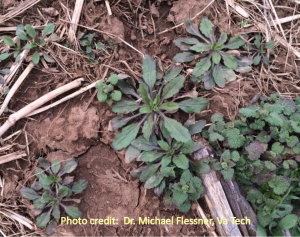There may be more peanut and cotton acreage planted in the V-C region this year than in 2016; and growers may wonder what crop to start planting first and which one last. These are legitimate concerns and we may have, at least in part, answers.
For peanut, mid-May planting seems to carry least risk compared with late April to early May or late May to early June plantings. This is quite common knowledge gathered through extensive research at the Tidewater Agricultural Research and Extension Center in Suffolk VA and Peanut Belt Research Station in Lewiston NC. However, researchers agree that all depends on the weather. For example, research I did in 2009, a relatively cool and wet year with 17 inches of rainfall from May through the end of August, clearly showed that April 20 planting resulted in a statistically significant yield reduction of 780 pounds per acre in comparison with a May 15 planting. At the state level, average yield in Virginia in 2009 was 3700 pounds per acre, similar with the average yield in 2016. Year 2010 was hot and dry with less than an inch precipitation in June, July and August combined. In this year, state average yield was only 1800 pounds per acre and our results indicated that April 15 planting of Bailey resulted in substantially more yield than late May (May 21) planting. The majority of other peanut commercial cultivars tested in that year responded in a similar way; but there were a few exceptions like Sugg, Gregory, and the runner Georgia 09B, which performed well when planted on May 3, but still low when plated on May 21. The first two weeks in May (maybe end of April too with good thrips control) may be best for peanut planting if April and May are warm with constant daily temperatures of 65 °F or more, sunny days, and night temperatures of 45 °F or more, and soil has “right” moisture; if moisture is excessive, the soil is probably cool. If April and May are cool and wet like last year, maybe waiting for after mid-May to plant peanut is the best option. Varieties seem to respond differently to planting time, but information on the new high oleic cultivars needs investigation.
In 2011 and 2012, I looked at how combination of planting date, seeding rate and tillage affects peanut yield. Results from these years were also dependent upon the specific weather conditions of each year. Across the state, both years were “good” years for peanut, with state averages of 4100 and 4200 pounds per acre; but in 2011, the hurricane in August dropped 18 inches of water at one time, and weather was considerably warmer than in 2012. In 2011, planting on April 25, May 5 or May 23 did not significantly changed yield, in particular when 5 or 6 seeds per foot-row were seeded. Some yield reductions were observed when only 3 seeds per foot were used. However, in 2012 Bailey yielded approximately 1000 pounds per acre more when planted on May 12 in comparison with April 30 and May 23 or June 1; and yields were about 100 pounds per acre greater in conventional versus strip till.
We concluded that the optimum time for peanut planting in Virginia is May 5 to May 20. Planting early may have lower yields due to thrips damage, and cool and wet soils; later plantings may also drop yield due to poor germination and crop stand; and recommended increase of seeding rate to 5 or 6 seeds per foot when planting outside this time window. More information on this research is here.
effect-of-planting-time-on-disease-yield


